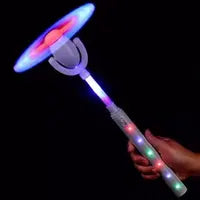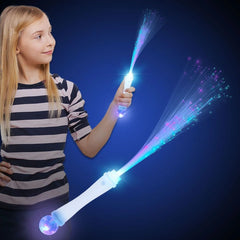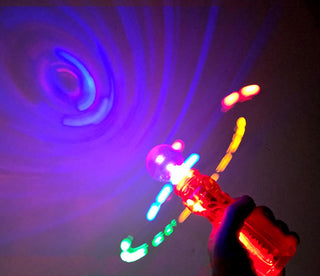Light Up Wands can be a fun and engaging tool for children with additional needs and/or Autism. These light up toys can provide sensory stimulation and can be incorporated into various play activities to support their development and engagement.
Ten Light Up Wand Play Ideas!
1. Visual Tracking Games: Encourage the child to track the movement of the wand's lights with their eyes. You can move the wand in different patterns and ask the child to follow its path. This helps with visual tracking and concentration.
2. Colour Recognition: Teach and reinforce colour recognition by asking the child to identify the colour of the lights as they change. Use simple colour cues, such as "Can you find the red light?"
3. Sensory Exploration: Allow the child to touch and explore the wand. The different textures and materials can provide sensory input. You can add tactile elements like soft fabric or textured stickers to enhance the sensory experience.

4.Cause and Effect: Show the child that their actions (spinning the wand) create the spinning lights. This helps them understand the concept of cause and effect. You can also introduce language like "When we spin the wand, the lights dance."
5. Gross Motor Skills: Encourage the child to use the light up wand for big, sweeping movements. They can practice drawing shapes, letters, or their name in the air with the wand's lights. This promotes gross motor skills and creativity.

6. Fine Motor Skills: For fine motor skills, have the child create more controlled and detailed movements with the wand. Ask them to trace shapes or patterns in the air or follow lines on a surface.
7.Music and Dance: Play calming or preferred music and encourage the child to dance with the wand. The wand can be used to express themselves through dance and movement.

8. Simon Says: Play a game of "Simon Says" using the sensory light's movements. For example, "Simon says make the lights twirl slowly" or "Simon says stop the lights." This game helps with listening and following instructions.
9. Storytelling and Imaginative Play: Incorporate the light up toys into imaginative play scenarios. It can become a magic wand with special powers, and the child can use it to solve problems in the story.
10. Social Play: If there are other children present, encourage group activities. For example, you can form a circle and pass the light up wand to the music. When the music stops, the child holding the wand can perform a special movement or action.

11. Calming and Sensory Breaks: Some children with autism may find the soothing lights of the wand helpful for self-regulation. Offer the wand as a sensory tool for moments when the child needs to self-soothe or take a break.
Always be attuned to the child's sensory preferences and comfort level. Some children may prefer soft, gradual movements, while others may enjoy more dynamic and rapid actions. Customise the sensory activities and sensory light toys to suit their specific needs and interests while providing a safe and enjoyable play experience.
Check out our huge range of Light Up Toys!

